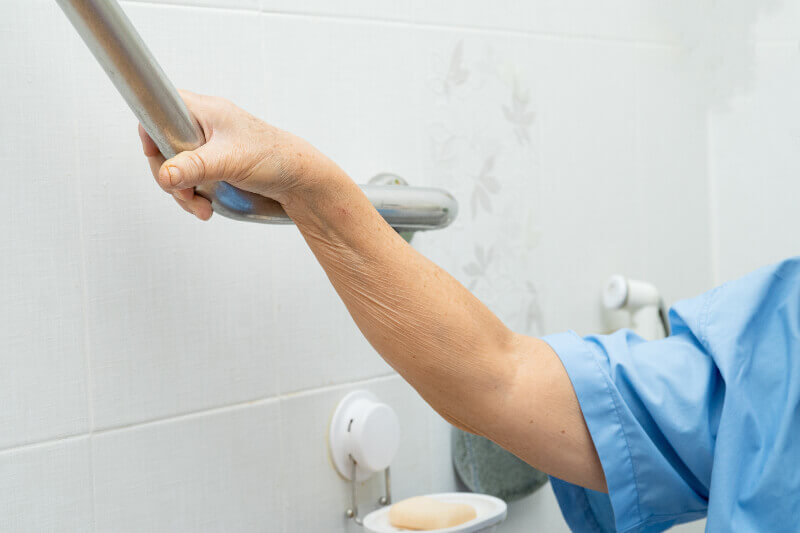
Perhaps you have bad knees, arthritis, or just simply above a certain age. Whatever the reason, we want you to enjoy the tub again. After all, bathing should be luxurious – not laborious.
You’re not alone, either. Many people around the UK still need help getting in and out of the bath, which is why we’ve put together this helpful guide.
Below, we explain how to avoid the most common problems getting out of the bath, offering tips, advice, and recommendations for supportive bathing aids. We’ve also included a step-by-step guide on how you can help someone else.
- Step-by-step: Help getting in and out of the bath
- Help for elderly users: Bathing safety aids
- Walk-in shower and wet rooms
Are you affected by mobility issues when bathing?
Simply complete our form to see a full range of bathing solutions & their key features. It takes no time at all!
Did you know? On average, UK adults spend 416 days of their life in the bathroom.
Step-by-step: Help getting in and out of the bath
If you’re wondering how to get out of the bath safely, you’ve come to the right place.
We know that the safest way to ensure slip-free bathtimes is by installing bathing aids, such as grab bars, side doors, and non-slip mats.
However, even with these additions, it can be tricky to stay safe. So, we’ve put together a step-by-step process for getting in and out of regular bathtubs. If you’re a caregiver, you can use this approach to guide the bather from start to finish:
- Wipe down the edge of the bathtub to ensure it’s not wet or slippery.
- From a sitting position, grab the edge and pull yourself onto your side.
- Move onto your hands and knees so that you’re facing the bottom of the tub.
- Keep hold of the edges and push yourself up onto your knees.
- Again, keep hold of the edges and slowly raise your knees from the bathtub floor.
- Bring one leg over the side of the tub, while holding onto the edges.
- Stand firmly with one leg inside and outside the tub, making sure the bathroom floor is dry.
- Raise the other leg and slowly bring it outside the tub, with your hands on the edges.
- You’ve now got both legs outside the tub, with both feet on dry ground.
These steps should be used as general guidance for when you’re helping someone get in and out of the bath. For instance, during steps 4-6, you might need to offer physical support to users with poor upper-body mobility.
Overall, when getting into and out of the bathtub, you should go at your own pace. It’s essential you don’t push yourself too much if you’re less mobile, so if that’s the situation then ensure you’re fully prepared. The most important thing is your safety, so if you don’t feel it would be safe doing this by yourself, then do consider other options.
Did you know? A YouGov survey found elderly people are twice as likely as young people to say they never take a bath.
Help for elderly users: Bathing safety aids
At Bathing Solutions, we believe in blissful bathtimes for all ages and abilities. To achieve high levels of relaxation, you might just need to install the right safety aid.
Safety aids offer comfort and independence, turning bath time into a low-risk yet highly enjoyable experience. With the right supportive aids, you shouldn’t need to rely on anyone else for help getting in and out of the bath anymore.
Below, we discuss the most popular bathing aids, from singular grab bars to electric hoists, explaining how they can help you enjoy bathing again.
Walk-in baths with doors and seats
The main reason why people need help getting in and out of the bath is exactly it – the act of stepping in and out the tub. Walk-in baths remove this risk.
Regular tubs have full side panels. But walk-in baths come with a side door, allowing you to step right in – over a very low threshold – and often to sit down on a built-in seat.
You can even have power seating that automatically lowers you in and out of the water, meaning you can relax your muscles without moving many at all.
Smaller bathroom? No problem. Half-length walk-in tubs use the same space as a regular shower cubicle, saving you stress and space in your bathroom. Most half-length bathtubs also come with slip-resistant seating, too.
You can take your walk-in bath experience to the next level with thermostatically-controlled taps that prevent accidental scolding, and luxurious extras such as heated seats and SpaTherapy.
Grab bars
The most common problems getting out of the bath can be solved by installing grab rails. They’re subtle, secure, and supportive – typically blending into the design.
To give you an idea of which type of grab rail might suit your needs most, just check out our comparison table:
| Grab bar | Supported weight | Key features |
|---|---|---|
| Integrated Riser | Up to 150 kg | Extra long riser bar
Shower head with five spray patterns Two-metre hose Integrated soap dish Additional shower head bracket |
| Fluted Plastic | Up to 200 kg | Increased grip
Available in three sizes (300 mm, 450 mm, 600 mm) |
| Standard | Up to 190 kg | Rust-proof stainless steel
Available in four sizes (300 mm, 450 mm, 600 mm, 900 mm) |
| Contemporary Straight | Up to 190 kg | Rust-proof stainless steel available in four sizes (355 mm, 480 mm, 620 mm, 900 mm) |
| Contemporary Curved | Up to 190 kg | Rust-proof stainless steel
Available in three sizes (355 mm, 480 mm, 620 mm) |
Looking for something more discreet? Alternatively, you can use 2-in-1 grab bars that double up as corner shelves, soap dishes, toilet roll holders, and towel rails.
That means you can enjoy discreet support while reducing clutter in your bathroom, combining style and security. The perfect combination.
Steps
Steps are a great way to elevate yourself if you have issues lifting your legs high. The bath step adds height and support, making it easier to lift tired legs over the side panel.
Non-slip mats
One in three adults over 65 years old – and half of the people over 80 years old – will have at least one fall a year. Anti-slip mats can help curb this trend, in the bathroom at least.
Overall, they’re a good value option, designed with simple suction cups for steadiness. They’re also relatively discreet, which is ideal for design-conscious bathers.
Inflatable bath cushion
By automatically inflating and deflating, bath cushions help you lie down and get back up.
Even with these cushions, you still need relatively strong upper body stability to push yourself back up. They’re not the most stylish bathing aid, either. However, they’re an affordable solution to most problems getting out of the bath.
Transfer bench
Versatile and easy to use, transfer benches are for when you need help getting in and out of the bath or shower cubicle. The way they work is also really simple.
You attach the transfer bench to the side of your bath, or next to your shower cubicle, then slide yourself onto your bathing seat. Just like walk-in baths, they remove the need for stepping on slippery floors.
Though not as discreet as using a bathtub side door, transfer benches still offer plenty of support.
Electric and manual hoists
Just like transfer benches, electric and manual hoists help move you inside and outside of the bath. You just sit down, press the appropriate button, and let the machine do its work. It’s that simple.
With manual hoists, you wind up a handle rather than press a button. Of course, this option requires a little extra manual effort but should cost far less than an electric hoist.
Walk-in shower and wet rooms
The ultimate way to avoid problems getting out of the bath? The ultimate solution is to remove the bath.
Replacing your tub with a more accessible feature, such as a wet room or walk-in shower, should mean that you’ll never need help getting in and out of the bath again. But what are they, exactly?
Wet rooms are the most accessible bathroom solution, offering unrestricted shower access within an open-planned, waterproofed section of your bathroom. Wet rooms are typically flush with the floor, meaning there’s no shower tray to step over – you just walk straight in. You can also install folding seats to support you while you wash.
Walk-in showers are similar to wet rooms, in that they’re far more accessible than regular bathtubs. You simply step right in. But – unlike wet rooms – they usually have a door and a low-level access shower tray.
Final thoughts
If you need help getting in and out of the bath, that’s okay. Although, now that you’ve read our guide, you should now have an idea about how you can enjoy more independent, luxurious bathtimes.






